This was published 7 years ago
Okinawa, Japan: The place where people have the longest lifespan - why do they live so long?
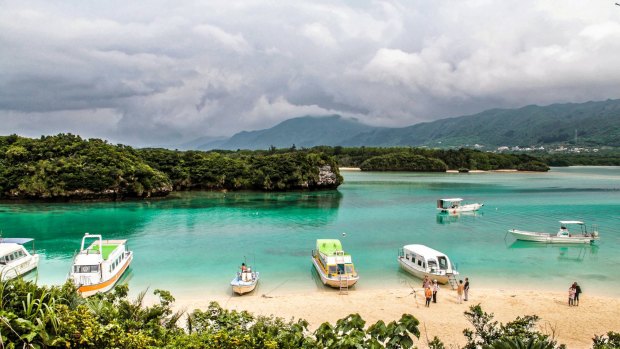
Okinawa: Per head of population, there are more centenarians on Okinawa than anywhere else.Credit: Michael Gebicki
"This," says Kazumi Kayo, "is one of the reasons we Okinawans live so long." We're in the Makishi Public Market in Naha, Okinawa's capital, and she's just handed me what looks like a lump of scaly wood. Smooth and tobacco coloured, tapering to a point at both. It's katsuobushi, dried and smoked bonito tuna. To Okinawans this is catnip, a flavour enhancer that you add to soups, the pork dishes that are an Okinawan specialty and just about any other main-course dish. You can buy it pre-flaked, in which case it looks like pink, feathery wood shavings, but diligent cooks like Kayo will shave off what they need, as you would with parmesan.
Kazumi Kayo operates Yonner Food, an experience into the Okinawan way of life via the medium of Ryukyuan cuisine and culture. We've spent half an hour with her trolling through the market, admiring tuna, parrot fish, sweet potatoes, lobster, the local version of donuts and odd bits of pork.
In the kitchen of her apartment she makes us rose tea, from hibiscus flowers which unfurl prettily in our glasses. Then it's down to business as we prepare pork belly in stock with soya garnished with katsuobushi, seaweed soup and a stir fry made with goya, the bitter gourd with a pimply skin, onion, carrot, more pork, eggs and tofu.
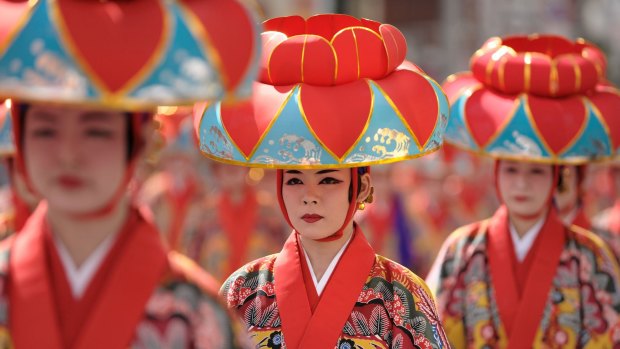
Traditional dance performers.Credit: iStock
Okinawans are famously long lived. Once past the age of 65, men can expect to live to about 84, for women it's close to 90. Per head of population, there are more centenarians on Okinawa than anywhere else, five times more than in the rest of Japan, and that's a high bar. Rates of cancer, stroke, coronary heart disease and depression are well below the average for advanced economies yet they don't go to gyms nor do they jog. Instead you can see elderly Okinawans working in their vegetable gardens, practising tai chi and riding bikes.
Food is part of the reason. It's a low-carb diet with lots of fruit, tofu, vegetables and seaweed. Rather than seafood, the No. 1 source of protein is pork, and not just the fatty pork belly but also pig's trotters, roasted pork ribs and pork ears, served thinly sliced, simmered slowly and dressed in sake vinaigrette. But is it just down to food?
"Maybe it's just happiness," according to Chris Dong, my guide, a former US Marine who met his Japanese wife when he was stationed on Okinawa, and stayed. "Okinawans are bonding, social animals, they spend a lot of time with family and friends, and they're incredibly supportive."
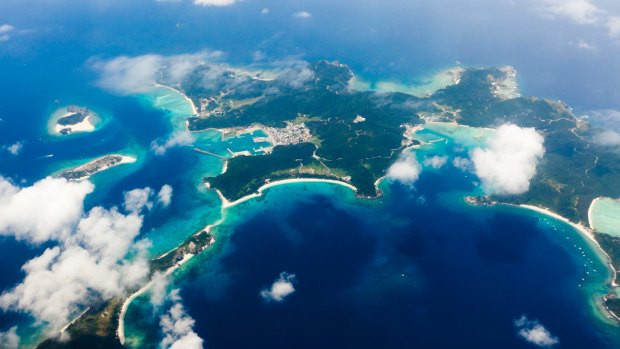
The clear blue waters of the Kerama Islands, Okinawa.Credit: iStock
Okinawans' longevity is not a given. Kazumi Kayo, in her 50s, tells me hers is the first generation of Okinawans that will not live as long as their parents. "Traditional food was also medicine," she says, "and it's slow food. Now people have less time so they go for convenience foods and that means a less healthy diet and we're seeing more and more health problems."
Okinawa is the largest of the Ryukyu Islands, the semi-circular archipelago of over 150 islands stretched between southern Japan and Taiwan.
In historic times the rulers of Okinawa owed their allegiance to the Chinese emperor, not to the bit-players in Japan. In Shuri Castle, former seat of the supreme ruler of Okinawa, a diorama shows a new ruler being anointed by emissaries from China. Until given the tick by China, he was a ruler in waiting. In the early 1600s the island was invaded by samurai sent by Japan's powerful Satsuma clan, the beginning of a slow but steady incorporation of the Ryukyu Islands into Japan's sphere of influence.
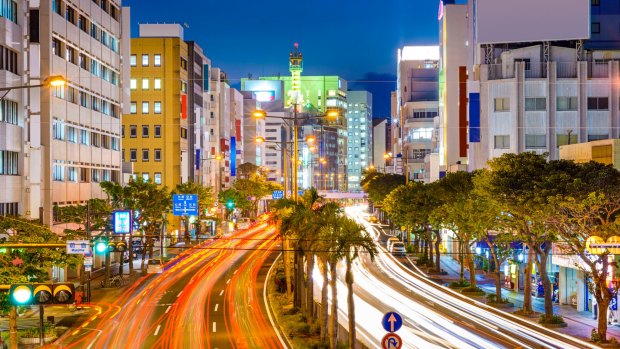
Naha, Okinawa.Credit: iStock
Another facet of Okinawan culture that traces its origins to China is the noble art of karate, open hand fighting. Chinese martial arts were first introduced around 1400 and when the Satsuma samurai banned weapons in the wake of their invasion, Okinawan karate put on a spurt. According to popular belief it was also this ban on weaponry that gave birth to the even more deadly martial art of kobudo, which uses farm and fishing implements including staves, oars and the chain-linked nunchaku to lethal effect.
Tetsuhiro Hokama is the director of the Okinawa Prefecture Karate Museum, found on the second floor of Hokama Sensei's dojo. It's a fascinating collection of photos, books and weaponry as well as a chance to peek at the classes that Hokama conducts for students who come from all over the world. Hokama's specialty is kyusho, attacking nerve points, which allows a small opponent to paralyse a much larger one. It also involves a severe toughening up exercise to withstand blows, also designed to weaponise elbows, hands, feet and knees. Just watching the pounding that goes on in the warm-up is painful.
In Naha, the Dojo bar is tribute to the fighting arts of Okinawa operated by British-born James Pankiewicz, a karate aficionado. It's a favourite hangout for expats as well as the local Okinawan martial arts community and Pankiewicz is the man to know if you've come here to work on your karate, or just absorb the atmosphere. The Dojo Bar is just as renowned for its range of British draught beers, wines and awomori-based drinks, cure-alls for any martial arts related disorders. Just don't go looking to fight.
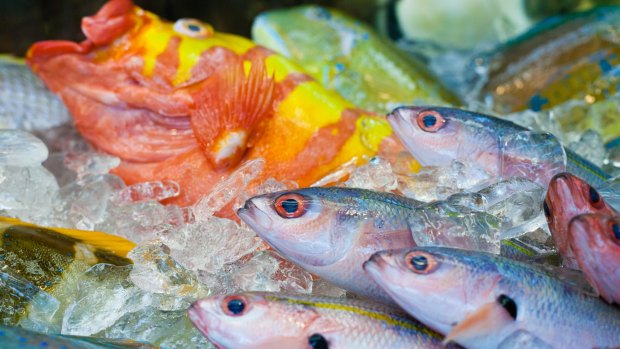
Freshly caught Japanese tropical fish displayed at a fish market.Credit: iStock
Although its people speak Japanese, go to bathhouses and arrange their empty footwear with geometric precision, Okinawa is not Japan. Okinawa is more chilled, less workaholic and less self conscious than the rest of Japan. It's where Japan takes its shirt off, a subtropical island with palm trees and flaming bougainvillea and diving on the to-do list. The flight in to Naha Airport takes you over a mottled sea dotted with coral reefs. Hawaiian style shirts are popular, and it was Okinawans living in Hawaii who introduced the splashy floral patterned shirt to the world. While Japan was historically isolationist, Okinawa was outward looking and multicultural.
"You should see our whales," says the man in the tourist office. "Between January and the end of March, humpback whales spend the winter here and you can see them leaping from the water."
"But I thought whale was a menu item," I said.
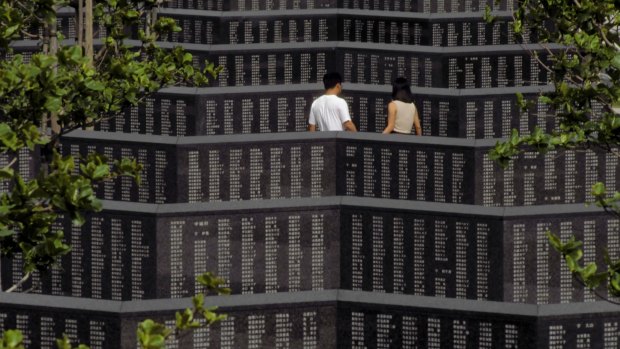
Looking for names of relatives lost in the Battle of Okinawa in World War II Credit: Alamy
"In Japan maybe, but Okinawa, never," he replied.
The food is different too, taking its roots from China. Okinawan soba is made with wheat flour rather than buckwheat while the local firewater is awamori, distilled sake. A variation is habushu, a jar of awamori with a pickled viper coiled in the bottom of the jar, fangs bared. The Okinawan language, the dominant dialect of the Ryukyu Islands, is incomprehensible to a Japanese speaker, and then there's the war.
This is one part of Japan that does not hesitate to mention World War II and the terrifying consequences of that war for their island home and its people.
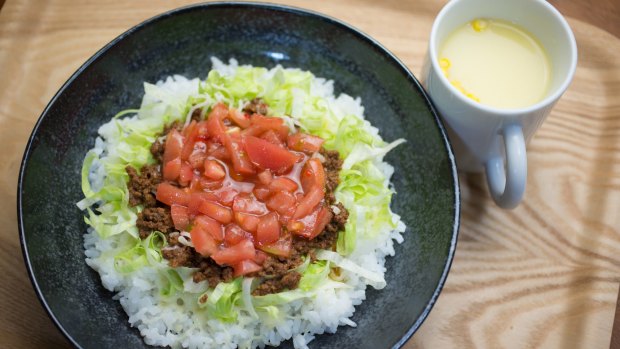
Taco rice is a Japanese dish and a popular example of Okinawan cuisine. Credit: iStock
Towards the end of the war in the Pacific it became obvious to the Japanese that an invasion of their homeland was inevitable as America and its allies advanced Island by island across the Pacific. To prepare the mainland for the invasion to come, the Japanese high command needed to delay the Allies for as long as possible, and Okinawa was to be a last-but-one stand.
The Battle of Okinawa, Operation Iceberg to the Allies, the "Typhoon of Steel" to the Japanese, was the last great battle of the War in the Pacific. On one side were 1300 ships, more than half a million men and thousands of aircraft of the US armed forces and their allies, including ships of the Royal Australian Navy. After D-Day this was the largest invasion fleet every assembled.
The Battle of Okinawa was one of the bloodiest of all the conflicts in the Pacific War. By the time it ended on June 22, 1945, allied casualties numbered more than 50,000, twice that number for the Japanese. For all the horrors inflicted as the militaries clawed at one another, it was the Okinawan civilians, caught in the middle, who suffered most. About a third of the island's population of 300,000 died in the battle.
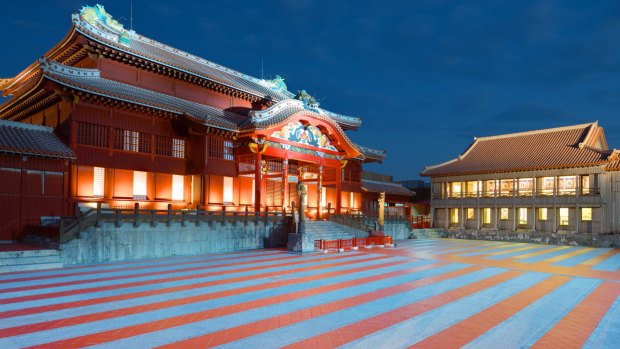
The exterior of Shuri Castle.Credit: iStock
Okinawa has several museums dedicated to the battle and they're outstanding, but the most poignant is the Himeyuri Peace Museum, dedicated to the 222 high school women and their teachers who were formed into a nursing unit to care for the injured soldiers who were being moved into rough shelters in the natural limestone caves that riddle the south of the island. Told they would only be needed for a short time, they brought their books, pens and notebooks, in which they recorded a living hell. These young women in their late teens found themselves caring for sick, traumatised, delirious and dying soldiers whose suffering they could do little to alleviate. Medicine, bandages and surgical equipment were virtually non-existent. They found themselves assisting surgeons performing amputations on patients who had only a sniff of ether to anaesthetise them, picking maggots with tweezers from the infected wounds of dying soldiers.
Food and water were scarce. When the students ventured outside from the precarious shelter of the hospital caves they found themselves under the withering bombardment laid down by the might of the US military.
Only a handful survived. Most lost their lives after deactivation was declared and the nurses, along with whomever of the injured could drag themselves away, were told to fight on and seek shelter wherever they could find it. They were also told the dire consequences that awaited them if they fell into the hands of the US military, a fate worse than death they were told, and many took their own lives.
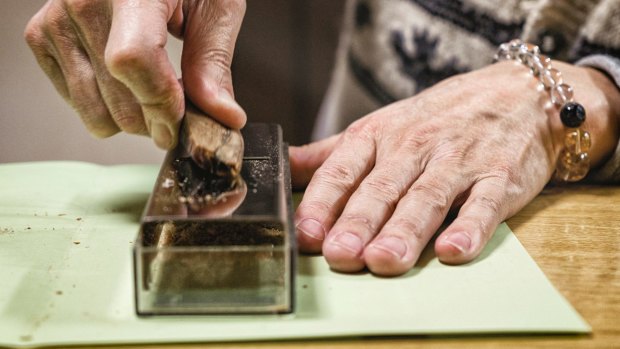
A Japanese man shaves a piece of bonito fish to create flakes used for seasoning in Japan. Credit: iStock
In all these museums there is no doubt who the Okinawans blame for the tragedy inflicted on their island, and that's all down to the Japanese military command. It was they who took the flower of their youth and conscripted them in the fight, starved the rest, subjected them to the horrors of the bombardment and executed those they accused of spying for the enemy, prepared to see them killed to the very last to forestall for as long as possible the inevitable assault on mainland Japan.
America still maintains a highly visible presence in Okinawa in the form of several vast military bases, the largest US military facility in Asia with about 50,000 military personnel plus families and civilian support staff. Those numbers also have an effect on what Okinawans eat, and not for the better. The classic American-influenced Okinawan fusion food dish is taco rice, hamburger mince with a handful of grated cheddar cheese tossed on top, tomatoes and shredded lettuce with a hot sauce plonked down on a bed of rice. I can't help but wonder what Kazumi Kayo would make of it.
BEST OF OKINAWA
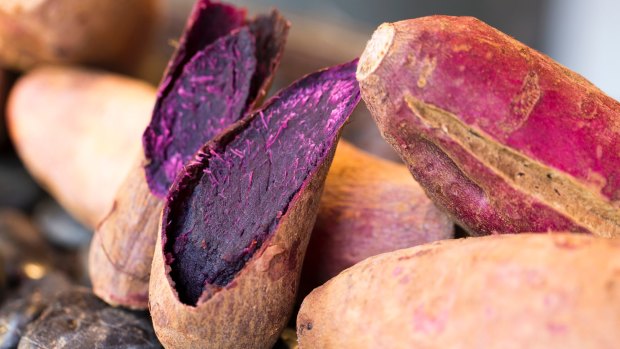
Okinawan sweet potatoes, known as murasaki imo. Credit: iStock
SHURI CASTLE
Vast and impressive hilltop castle dating from about the 12th century. Once the seat of the overlord of the Ryukyu Islands, destroyed in WWII but faithfully reconstructed.
SHIKINAEN GARDEN
Woodland garden, once part of the royal palace complex, with both Japanese and Chinese elements, now with a World Heritage listing.
SEIFA-UTAKI SHRINE
A forest shrine that was once the most sacred place in the Kingdom of Ryukyu, under the supervision of the Kikoe no Okimi, the highest female religious leader, and off limits to men.
OKINAWA PREFECTURAL PEACE MEMORIAL MUSEUM
In it exploration of the chilling impact of the war on Okinawa's population, this museum promotes the concept of the "Okinawan Heart", respect for personal dignity, rejection of aggression and the embrace of culture.
NAKIJIN CASTLE
Only an outline remains of this hilltop fortress, once the capital of one of the three kingdoms of Okinawa, but the World Heritage castle is beautifully sited, surrounded by forest and graced with cherry trees which bloom in January.
TRIP NOTES
MORE
FLY
Japan Airlines has several flights daily to Okinawa from Tokyo's Haneda Airport. au.jal.com/aul/en/
STAY
Naha has many different hotel options and the city is a good base for exploring the island's main attractions, most of which are in the south of the island. The Rihga Royal Gran Okinawa (rihgaroyalgran-okinawa.co.jp/en/) and the Mercure Okinawa Naha (mercure.com) are two sturdy performers. Further north, the Hilton Okinawa Chatan Resort (hilton.com) is the best of Okinawa's resort-style hotels.
TOUR
The six-day World Expeditions Okinawa Explorer adventure costs from $3590 per person, departing Naha. worldexpeditions.com
Michael Gebicki travelled as a guest of World Expeditions, Okinawa Tourism and Japan Travel.
See also: 20 things that will shock first-time visitors to Japan
See also: Beyond Tokyo and Kyoto - where visitors should head next
Sign up for the Traveller Deals newsletter
Get exclusive travel deals delivered straight to your inbox. Sign up now.